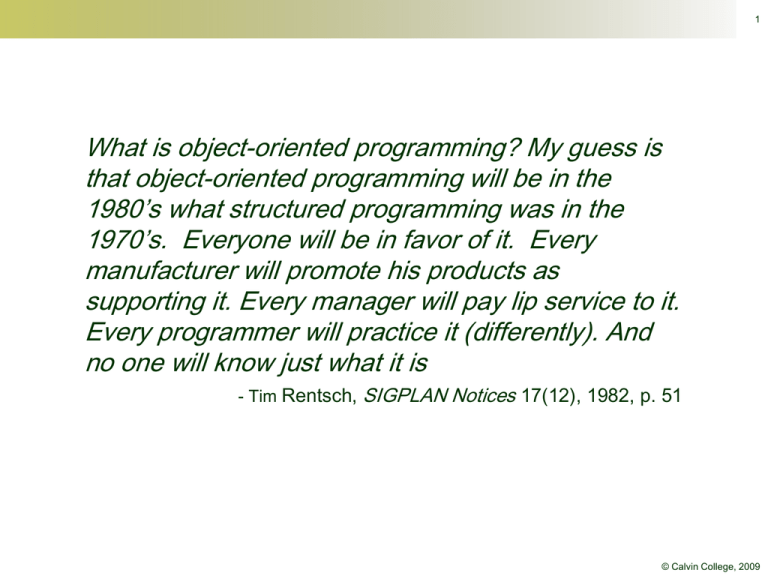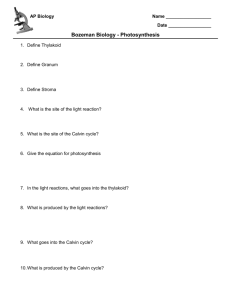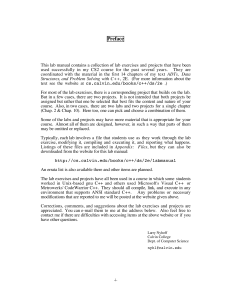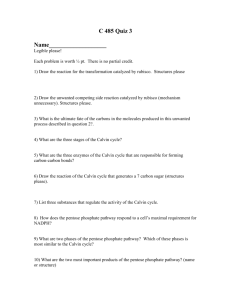What is object-oriented programming? My guess is
advertisement

1
What is object-oriented programming? My guess is
that object-oriented programming will be in the
1980’s what structured programming was in the
1970’s. Everyone will be in favor of it. Every
manufacturer will promote his products as
supporting it. Every manager will pay lip service to it.
Every programmer will practice it (differently). And
no one will know just what it is
- Tim Rentsch, SIGPLAN Notices 17(12), 1982, p. 51
© Calvin College, 2009
2
Introduction to Classes
●
●
Example
Introduction to Classes
–
Using Classes
– Designing Classes
– Implementing Classes
– Further Iterations
●
Object-Oriented Programming Languages
© Calvin College, 2009
3
Example: Analysis (1)
●
●
We’d like to display a
shower with hundreds
of rain drops.
A sample image
of this vision is shown
here.
© Calvin College, 2009
4
Example: Analysis (1)
●
The program should:
Represent a list of
rain drops;
– The rain drops should
fall down the output
pane;
–
© Calvin College, 2009
5
Iteration 0
●
Analysis
●
Design
●
Implementation
●
Test
© Calvin College, 2009
7
Classes
●
●
Classes encapsulate object types.
In object-centered design we
–
Reuse old classes where possible
– Build new classes when necessary
●
Each new class that we design and build
should have a coherent set of:
–
Knowledge
–
Responsibilities
© Calvin College, 2009
8
Naval Ships
Non-Combat
Combat
Submerged
Supply
Green Valley Class:
TAK 2049 - Green Valley
TAK 9204 - Jeb Stuart
Submarines
Los Angeles Class:
Surface
Carriers
Nimitz Class:
Battleships
Iowa Class:
SSN 688 - Los Angeles
SSN 689 - Baton Rouge
CVN 68 - Nimitz
CVN 69 - Eisenhower
BB 61 - Iowa
BB 62 - New Jersey
Virginia Class:
Kitty Hawk Class:
Montana Class:
NSSN 774 - Virginia
NSSN 775 - Texas
CVA 63 - Kitty Hawk
CVA 64 - Constellation
BB 68 - Ohio
BB 69 - Maine
images from http://www.warships1.com/
© Calvin College, 2009
9
Classes and Objects
●
●
Classes describe sets of similar objects by
specifying their:
–
Attributes
–
Behaviors
Each object has its own copies of the
attribute values.
© Calvin College, 2009
10
Using Classes
●
When you use a class object:
–
The calling program doesn’t know:
•
•
–
●
How to initialize the object’s data
How to implement the object’s methods
The object itself is responsible for these
things.
The calling program accesses them by
calling predefined methods.
© Calvin College, 2009
11
Iteration 1
●
Analysis
●
Design
●
Implementation
●
Test
© Calvin College, 2009
12
/**
* ... appropriate documentation ...
*/
final int WIDTH = 400, HEIGHT = 600;
Drop drop;
void setup() {
size(WIDTH, HEIGHT);
background(255);
smooth();
drop = new Drop();
}
void draw() {
background(255);
drop.move();
drop.display(HEIGHT);
}
© Calvin College, 2009
13
Designing Classes
●
●
When we want to work with objects not
supported by existing types, we must
design a new class.
The key design issues here are:
–
What classes do we need?
–
What goes in them (and what doesn’t)?
© Calvin College, 2009
14
Information Hiding
●
When we design a class we distinguish:
–
the external interface to a class;
– the internal implementation of the class.
●
The principle of information hiding dictates
that a class designer:
–
provide public views of those things that a
class user really needs to know;
– hide all other details by making them private.
© Calvin College, 2009
15
Design using Perspectives
●
Use an external perspective to specify the
public interface to a class.
●
Use an internal perspective to specify the
internals of the class design.
© Calvin College, 2009
16
Implementing Classes
●
●
Implementing the class attributes
Implementing the class methods:
–
Constructors
•
•
Default-value constructor
Explicit-value constructor
–
Accessors
–
Mutators
–
Other Methods
–
Object Interaction
–
Copy Constructors
© Calvin College, 2009
17
Class Attributes
●
Drop objects will certainly have to
encapsulate their own:
–
x-y coordinates;
– Diameter;
●
These will be stored as instance variables,
which means that each Drop object will
have its own versions of these values.
© Calvin College, 2009
18
Implementing Class Attributes
class Drop {
private final color COLOR = color(10, 10, 200, 100);
private
private
private
private
float
float
float
color
myX, MyY;
myDiameter;
myVelocity;
myColor;
// x-y coordinates
// raindrop diameter
// falling speed
// other class stuff here…
}
© Calvin College, 2009
19
Default-Value Constructor
External View (in the driver):
Drop drop1 = new Drop();
Internal View (in the class):
/**
* Construct a new Drop
* with default values
*/
public Drop() {
myX = 0;
myY = 0;
myDiameter = 5;
myVelocity = 5;
myColor = COLOR;
}
drop1
myX
0
myDiameter
5
myY
0
myVelocity
5
myColor 10,10,200,100
© Calvin College, 2009
20
Constructors as Methods
●
Constructors are like methods except that:
–
They have no return type
– They are given the same name as the class
– They are invoked with new:
Drop drop = new Drop();
●
●
Constructors initialize instance variables within
the limits set by the invariants.
Constructor methods are often overloaded.
© Calvin College, 2009
21
Class Invariants
●
Objects must maintain the integrity of
their internal data.
/**
* Print a message & stop if the diameter is negative.
* @param diameter the value to check
* @return verified diameter value
*/
private float checkDiameter(float diameter) {
if (diameter < 0) {
println("invalid diameter: " + diameter);
stop();
}
return diameter;
}
© Calvin College, 2009
22
Explicit-Value Constructor
External View:
Drop drop1 = new Drop(25, 50, 10, 3);
Internal View:
myX
25
myDiameter
10
/**
drop1
myVelocity
myY 50
3
* Construct a new Drop
myColor 10,10,200,100
* @param x the x-coordinate
* @param y the y-coordinate
* @param diameter the non-negative diameter
* @param velocity the falling speed
*/
public Drop(float x, float y, float diameter, float velocity) {
myX = x;
myY = y;
myDiameter = checkDiameter(diameter);
myVelocity = velocity;
myColor = COLOR;
}
© Calvin College, 2009
23
Accessor Methods
/**
* @return my x coordinate
*/
public float getX() {
return myX;
}
/**
* @return my y coordinate
*/
public float getY() {
return myY;
}
/**
* @return my diameter
*/
public float getDiameter() {
return myDiameter;
}
© Calvin College, 2009
24
Mutator Methods
/**
* Change my y position based on my drop velocity
*/
public void move() {
myY += myVelocity;
}
/**
* Set a new diameter value
* @param diameter non-negative diameter value
*/
public void setDiameter(float diameter) {
myDiameter = checkDiameter(diameter);
}
© Calvin College, 2009
25
Other Methods
/**
* Draw myself on the output panel provided that I'm still visible.
* @param height the height of the output panel
*/
public void display(int height) {
if (myY <= height) {
fill(myColor);
stroke(0);
arc(myX, myY, myDiameter, myDiameter, 0, PI);
noStroke();
triangle(myX, myY - myDiameter*1.5, myX - myDiameter/2, myY,
myX + myDiameter/2, myY);
stroke(0);
line(myX, myY - myDiameter*1.5, myX - myDiameter/2, myY);
line(myX, myY - myDiameter*1.5, myX + myDiameter/2, myY);
}
}
© Calvin College, 2009
26
Object Interaction
●
Sometimes objects must interact with each
other.
/**
* Suck up the volume of neighboring drops if they are close enough.
* Don’t do this if I am already sucked dry.
* @param other reference to one other drop object
*/
public void combine(Drop other) {
float otherRadius = other.getDiameter() / 2;
if ((myDiameter != 0) &&
(dist(myX, myY, other.getX(), other.getY()) <
(myDiameter/2 + otherRadius + COMBINE_FACTOR))) {
myDiameter += sqrt(2) * otherRadius;
other.setDiameter(0);
}
}
© Calvin College, 2009
27
Copy Constructors
●
We can’t “copy” objects as follows:
Drop drop1 = new Drop();
Drop drop2 = drop1;
This only copies the reference.
●
Thus, we must write copy constructors:
Drop drop1 = new Drop();
Drop drop2 = drop1.copy();
© Calvin College, 2009
28
Copying Objects
/**
* @return a copy of myself
*/
public Drop copy() {
return new Drop(myX, myY, myDiameter);
}
© Calvin College, 2009
29
Iteration 2
●
Analysis
●
Design
●
Implementation
●
Test
© Calvin College, 2009
34
OO Programming Languages
●
Simula
–
–
–
●
What’s the
Big Idea
Ole-Johan Dahl and Kristen Nygaard
Developed in the mid-1960’s
Used as a simulation language
Smalltalk
–
–
–
Xerox PARC project lead by Alan Kay
Developed in the early 1970’s
Used to support interactive computing
images from www.ifi.uio.no
© Calvin College, 2009




